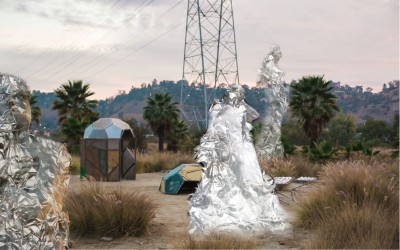Expedition notes
October 12, 2092
National Garden of American Heroes
West banks of the Missouri River, North Dakota
Re: Objects found at this location offer contradictions
-
A glacial erratic boulder was found within the perimeter of the National Garden of American Heroes with mineral content similar to landscapes located 1,600 miles to the northeast, along the southern regions of the Arctic Ocean, specifically the islands forming an archipelago located within a bay known as Kangiqsualuk ilua in Inuktitut language. It is believed that this boulder was moved to the Missouri River banks approximately 10,000 years ago by the melting glaciers. Even though at the entrance of the park there is a statement regarding the permanence of monuments, the large-scale glacial erratic demonstrates that no monument is permanent, that even large boulders migrate, and that the Earth is in a state of flow.
-
During the last glacial period, part of the Earth's water froze over regions later known as North America and Europe and the sea levels dropped exposing sea floors of shallow seas such as the Bering Strait, which currently is approximately 55 miles deep, although its levels continue to rise with global warming. It is believed that thousands of humans crossed these land bridges from what is now called Siberia into what is now known as the American continent. This might explain the human remains of approximately 11,000 years of age found under the statue of Christopher Columbus within the perimeter of the National Garden of American Heroes. Ironically, such statue had on its pedestal a plaque that stated that such historic figure had "discovered the Americas" in the year 1492. Further evidence was found in the area to demonstrate that the region was amply populated prior to the date listed in the plaque, therefore offering proof that this individual had not discovered but merely arrived to a location where others lived.
-
Several of the statues found within the perimeters of the park were protected from an unidentified threat, some with local river rock walls, others with wood fences, but many with concrete walls topped with barbwire. This peculiar way of installing the lifelike sculptures included statues of Antonin Scalia, Alexander Hamilton, James Madison, Billy Graham, and George Washington. The points of coincidence between the sculptures that were protected by walled barricades and barbwire were not identified. The following information emerged:
a. Records show that Scalia was born in Trenton, New Jersey in 1936. He was a controversial member of the supreme court of the United States who often spoke against civil rights and against equality. Presidio County Judge Cinderela Guevara pronounced him dead when she was informed over the phone by local officers that there was no foul play in his room, the "El Presidente" suite at the Cibolo Creek Ranch, an exclusive hunting resort some 40 miles south of Marfa, Texas.
b. Alexander Hamilton was born in 1757 in the Caribbean region. Born in Charlestown, Nevis, in Leeward Islands, British West Indies, he migrated as a teenager to the British colonies, which later became the United States. He died while participating in a duel in Greenwich Village, New York on July 12, 1804.
c. James Madison was born in 1751 in Port Conway, Virginia. He was known as the father of the Constitution and also as the owner of a tobacco plantation operated by numerous slaves who suffered periodic corporal punishments.
d. Billy Graham, born William Franklin Graham Jr. on November 7, 1918 was an Evangelical Christian minister during a period when television and radio broadcasts became popular. He began as a segregated evangelist. However, he broke the segregation within his audience and stated: "we have been proud and thought we were better than any other race, any other people. Ladies and gentlemen, we are going to stumble into hell because of our pride," and that "there is no spiritual basis for segregation." However, in his recorded conversations with President Nixon he also stated that the Jewish "stranglehold has got to be broken or the country's going down the drain." He also claimed that women's role was in the home, as a wife and a mother, and stood against women obtaining access to higher education. Inside the 45 Library, a New York Times article dated March 19, 1970 documents that as a result of the publication of his views, "more than 100 militant feminists staged a day-long occupation of The Ladies' Home Journal's editorial offices." The article states that "the demonstrators had also demanded the replacement of the editor and publisher, John Mack Carter, by a woman, an all-woman advertising and editorial staff, and to end 'exploitative' advertisements."
e. George Washington, the first president of the United States, was also the owner of plantations and a distillery. He is known as a man who freed his slaves because he left a provision in his will that they were to be freed after his wife's death. However, not all his slaves were freed after her death because she had been married before and when she died almost half of Washington's slaves were returned to her former husband's estate, where they remained enslaved.
- An unknown plague has been growing for years over some of the sculptures, making it impossible to read the plaques or to identify the names of the persons depicted by the sculptures. The plague shows a repeated pattern, like that of a fractal, rendering the lifelike sculptures abstract. A sample of the moss-like growth has been sent to the laboratories for further study. This sample is identified as 20921012-69.
Appendix: Executive Order 13934.
